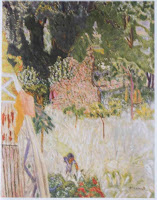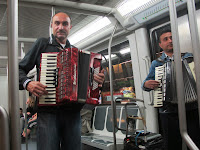After a day of a needed rest-up I'm all refreshed and off on the early morning train from Gare Montparnasse (this means I have now left Paris from everyone of its main railway station in the City - there are 6 stations). The train was not a TVG but only managed 160kmh according to my GPS. We are very far behind he rest of the world on our public transport in the land of Oz..
 Chartres was not a very large city/village, I walked from the station to the Cathedral in about 10 minutes. After checking out what to do I decided I would do the Village walk with an audio guide and return at 14:30 to do the main Cathedral.
Chartres was not a very large city/village, I walked from the station to the Cathedral in about 10 minutes. After checking out what to do I decided I would do the Village walk with an audio guide and return at 14:30 to do the main Cathedral. I started the walk from the main entrance of the Cathedral and walked around the south side though interesting village streets.Walking past the Canon's house the city wall gates and small clock tower with a 24hour, one had clock. A little audio information about the very famous stain glass windows - I was to listen to an audio on the windows later on in the afternoon.
I started the walk from the main entrance of the Cathedral and walked around the south side though interesting village streets.Walking past the Canon's house the city wall gates and small clock tower with a 24hour, one had clock. A little audio information about the very famous stain glass windows - I was to listen to an audio on the windows later on in the afternoon.
 I then proceeded to the terrace of the Bishop's palace where there was an nice view of the Chartre Town. Then I walked down a long stairway past some very ancient houses and a very old church - Saint Andre collegial church and St Nicolas fountain. Onwards to St Thomas's bridge crossing. the Euro river. Old mills and public washing platforms were pointed out. These were allocated for males on some days then females on other days. In the lower town the river provided a very nice setting the old houses built on the banks and framed by hanging willow branches, the Bouju bridge, and colourful spring blooms in riverside gardens.
I then proceeded to the terrace of the Bishop's palace where there was an nice view of the Chartre Town. Then I walked down a long stairway past some very ancient houses and a very old church - Saint Andre collegial church and St Nicolas fountain. Onwards to St Thomas's bridge crossing. the Euro river. Old mills and public washing platforms were pointed out. These were allocated for males on some days then females on other days. In the lower town the river provided a very nice setting the old houses built on the banks and framed by hanging willow branches, the Bouju bridge, and colourful spring blooms in riverside gardens.
 We came to a busy village corner where the trail turned and crossed a larger bridge, over a wider branch of the Eure, with some old ruins on either side. An archeological dig was set-up on the far bank with some information signs. The bridge is called the Guilleum (that is: William) Gate Bridge and it was blown up by revengeful German solders as they retreated from the British advance in 1944. There was originally a very large gatehouse with high stone walls. When I was taking some photos a very old lady shuffled up to me and started talking to me in French insisting that I should take certain photos to capture the importance of the destruction and to emphasis what was there beforehand. She was unconcerned that I could hardly understand her and she dragged me across to a small shop window where there was a collection of old photographs in a frame. It became clear that she was there when the Germans blew up the bridge and that I was very lucky to have this encounter. She was also delighted that the city had been given money to do the archeological research and re-build the old gatehouse.
We came to a busy village corner where the trail turned and crossed a larger bridge, over a wider branch of the Eure, with some old ruins on either side. An archeological dig was set-up on the far bank with some information signs. The bridge is called the Guilleum (that is: William) Gate Bridge and it was blown up by revengeful German solders as they retreated from the British advance in 1944. There was originally a very large gatehouse with high stone walls. When I was taking some photos a very old lady shuffled up to me and started talking to me in French insisting that I should take certain photos to capture the importance of the destruction and to emphasis what was there beforehand. She was unconcerned that I could hardly understand her and she dragged me across to a small shop window where there was a collection of old photographs in a frame. It became clear that she was there when the Germans blew up the bridge and that I was very lucky to have this encounter. She was also delighted that the city had been given money to do the archeological research and re-build the old gatehouse.
The loss of culture and history is one of the greatest impacts of the world wars in Europe. WWII caused the greatest loss of life of all wars in human history. Basically big and powerful schoolyard bullies doing their worst to each other and using the simple people and their culture as pawns in their evil games. All the direct civilian bombing done by all sides were direct contraventions of all the "Just War" conventions agreed by all at the time (although the UK did not sign the London Agreement but this omission does means the laws do not apply to them). All these "strategic bombing" "campaigns" and their justification under the cry of "Total War" were war crimes of the highest magnitude and there are many leaders on all sides who should be standing the world court justifying their decisions to use civilians and desperate refugees as tools in their wars. The politicians who negotiated the Versailles Treat in 1919 are the root course of WWII and nearly all the conflicts since.
 From Guilleum's Bridge I walk up the hill passed some beautifully restored old houses, in particular one with an external spiral stairway tower. This staircase was called the Queen Berthe's Staircase. Here I became the curiosity object for some school children who very quickly became very friendly and we conversed in a mix of French and German and they allowed me to take some photos of them. They were very interested in where I came from and how many kilometers I travelled from Australia to get here. They told me that they were out of school on a lunch break and would have to return soon. (Painting of girl added Sept 2011)
From Guilleum's Bridge I walk up the hill passed some beautifully restored old houses, in particular one with an external spiral stairway tower. This staircase was called the Queen Berthe's Staircase. Here I became the curiosity object for some school children who very quickly became very friendly and we conversed in a mix of French and German and they allowed me to take some photos of them. They were very interested in where I came from and how many kilometers I travelled from Australia to get here. They told me that they were out of school on a lunch break and would have to return soon. (Painting of girl added Sept 2011)
 I continues down the Flat-Foot stairs back to the river and crossed the Taillard Bridge. There were pretty scene of old riverside buildings and gardens and I re-crossed the river on the Saint-Hilaire bridge to pass the children's school and to briefly visit the Saint-Pierre church with its large flying buttresses and excellent stain glass windows. The ceiling plaster was falling down and a large net had been suspended underneath to protect people in the church.
I continues down the Flat-Foot stairs back to the river and crossed the Taillard Bridge. There were pretty scene of old riverside buildings and gardens and I re-crossed the river on the Saint-Hilaire bridge to pass the children's school and to briefly visit the Saint-Pierre church with its large flying buttresses and excellent stain glass windows. The ceiling plaster was falling down and a large net had been suspended underneath to protect people in the church. A little father up the hill was a smaller church which was also very interesting. The highly decorated ceiling and beautifully painted stain glass windows telling the usual story of the old Testament and the wages of sin. These windows were for the illiterate people to visually "read" the bible as well as to impress them of the importance of the local church leaders at the time.
A little father up the hill was a smaller church which was also very interesting. The highly decorated ceiling and beautifully painted stain glass windows telling the usual story of the old Testament and the wages of sin. These windows were for the illiterate people to visually "read" the bible as well as to impress them of the importance of the local church leaders at the time. I continued up Grenet St passing some old houses with interesting brick and stone work facades on the old Citizen's Council Room. Passed the old market place at Billard Square and oldest building called the salmon house because of the fish on the front column.
I continued up Grenet St passing some old houses with interesting brick and stone work facades on the old Citizen's Council Room. Passed the old market place at Billard Square and oldest building called the salmon house because of the fish on the front column.
This was the end of the city walk and I returned to the Chartre Cathedral. I picked up the audio tour of the Cathedral and this mainly deal with the details of al the amazing stain glass windows and who funded the creation of each one. The local weapon makers, the money traders and the shoes makers etc. no doubt guaranteeing them a place in heaven. The choir stalls were surrounded by panels of intricacy carved picture stories of the life of Christ and Mary of course.

 I walked around the inside of the cathedral looking at all the elaborate chapels with many candles burning (2-5 ?? Euros to light a candle - size is important to get the message though)
I walked around the inside of the cathedral looking at all the elaborate chapels with many candles burning (2-5 ?? Euros to light a candle - size is important to get the message though)I got the 5pm train back to Paris and slept all the way. Luckily Paris was the termination.
I had to finalise my packing for the flight back to Australia on Tuesday. I had to check Fritz's list to ensure I had watered all the plants and locked up correctly. Get my overloaded pack and ski equipment thought the Korean Airline weight check proved to be a challenge but a little juggling and some slight of hand got it all through without any extra charge.
































